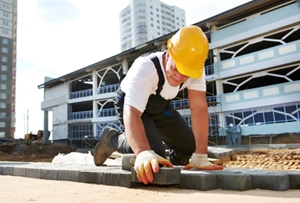Unlocking the Secrets of Lasting Masonry Building Practices for Eco-Friendly Buildings
Amongst the myriad approaches to environmentally friendly building, lasting stonework building and construction stands out as a reliable and sturdy method that holds a wide range of untapped possibility. From the choice of materials to cutting-edge construction techniques, the tricks to achieving sustainability within masonry construction are multifaceted and interesting.
Benefits of Sustainable Masonry Building And Construction
Embracing lasting stonework building and construction practices not just minimizes ecological impact yet also uses long-term economic advantages to builders and communities. By making use of materials like recycled blocks, blocks, and stones, builders can considerably decrease the carbon footprint of their jobs while promoting source efficiency. Furthermore, lasting masonry construction methods, such as appropriate insulation and thermal mass properties, can improve energy efficiency within structures, causing reduced operational prices in time.
Additionally, the resilience and strength of masonry structures add to long-term financial advantages. Buildings created using lasting stonework techniques commonly call for much less repair and maintenance, translating to set you back savings for contractors and residential or commercial property owners. The long life of stonework materials also guarantees that frameworks continue to be steady and secure, minimizing the need for constant remodellings or replacements.
Eco-Friendly Masonry Materials
Making use of environmentally friendly masonry materials is a critical step in the direction of boosting the sustainability of construction methods and lessening environmental effect while taking full advantage of long-lasting economic benefits. Sustainable masonry materials are sourced, generated, and utilized in a manner that lowers total ecological effect. Materials such as recycled blocks, reclaimed rock, and lasting cinder block are ending up being increasingly preferred choices for eco-conscious home builders. Recycled blocks, as an example, not just draw away waste from garbage dumps yet also call for much less power to produce contrasted to brand-new blocks. Reclaimed rock offers an one-of-a-kind visual appeal while reducing the requirement for brand-new quarrying. Lasting concrete obstructs integrate recycled aggregates and may include enhanced insulation residential properties, adding to energy performance in structures.
Moreover, natural products like adobe, rammed earth, and straw bundles supply outstanding thermal mass buildings, reducing the requirement for home heating and cooling down energy. These materials are typically locally offered, promoting regional economies and lowering transportation-related carbon discharges. By selecting environmentally friendly masonry products, building jobs can dramatically decrease their ecological impact and add to the creation of healthier, more lasting built environments.
Energy-Efficient Stonework Methods
Power performance plays a critical role in improving the sustainability of masonry building practices. One essential energy-efficient masonry strategy is the use of thermal mass, which entails integrating dense products like concrete or block into the structure's framework to absorb and save warm.

Advancements in Sustainable Masonry
Current innovations in sustainable masonry methods have caused cutting-edge methods that are reshaping the building market. One such technology is the advancement of self-healing concrete, which uses germs installed within the resource concrete to recover fractures autonomously. This advancement not just minimizes upkeep prices however also boosts the longevity of stonework frameworks, adding unique auto sales to their sustainability.
One more notable innovation is the usage of recycled accumulations in stonework building and construction - masonry contractor. By integrating materials such as crushed ceramic waste or recycled glass right into concrete mixes, home builders can minimize the ecological influence of building and construction tasks while preserving architectural integrity. This technique not just draws away waste from land fills however likewise preserves natural deposits, making it a crucial advancement in sustainable stonework construction
Furthermore, the integration of digital design tools, such as Structure Info Modeling (BIM), is transforming the way stonework structures are intended and built. BIM permits for more precise calculations, lowered material wastefulness, and boosted power effectiveness, eventually resulting in even more lasting building techniques. These innovations jointly signify a promising future for lasting stonework construction in the period of eco-friendly buildings.
Future Trends in Masonry Sustainability
With the ingenious strides made in sustainable masonry techniques, the future patterns in masonry sustainability are poised to more change the building and construction sector. One of the crucial trends forming the future of masonry sustainability is the boosted assimilation of innovation. Developments such as Building Details Modeling (BIM) and virtual fact simulations are being used to enhance masonry building and construction procedures, resulting in minimized material waste and boosted power performance in buildings.
Additionally, the growth of novel sustainable materials is readied to play a significant role in boosting the eco-friendliness of masonry construction. masonry contractor. Developments like self-healing concrete, recycled accumulations, and bio-based binders are acquiring grip for their ability to decrease environmental effect while preserving structural stability

Conclusion
In verdict, lasting masonry building techniques supply numerous advantages for green buildings. masonry contractor. Developments in lasting stonework are continually being established to even more improve the ecological performance of buildings.